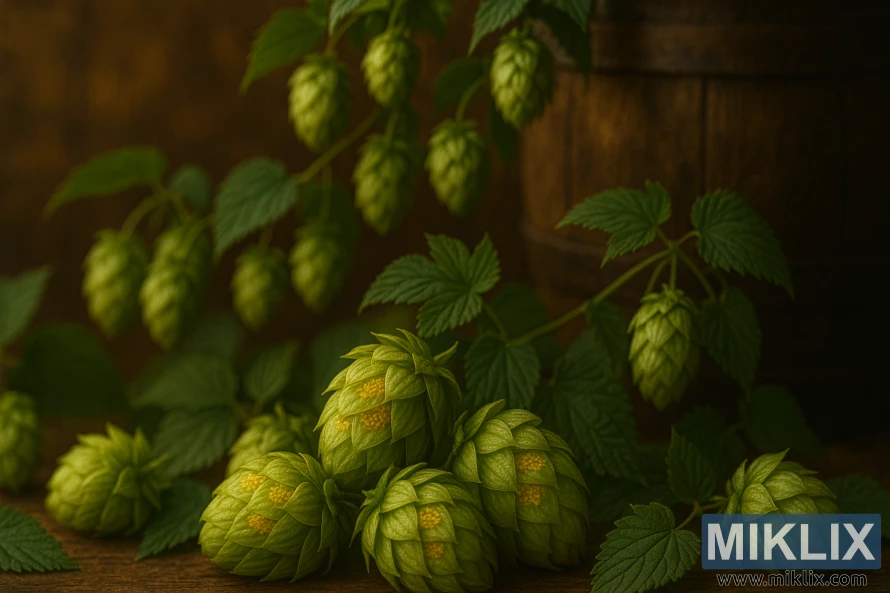Image: Still Life of Cobb Hops with Rustic Brewery Setting
Published: October 12, 2025 at 8:45:18 AM UTC
A high-resolution still life of Cobb hops arranged on a wooden surface with cascading bines and a rustic barrel in the background, highlighting lupulin glands and artisanal brewing craftsmanship.
The image depicts a lush and vibrant still life composition featuring Cobb hop cones arranged with an artisanal, almost painterly sensibility. In the foreground, plump hop cones lie gracefully across a wooden surface, their scales layered in spirals of bright green and edged with subtle golden tones. The overlapping bracts are slightly translucent, allowing the viewer to catch glimpses of the resinous lupulin glands within. These lupulin deposits shimmer warmly under the soft golden light, evoking the rich, aromatic qualities that hops impart to beer.
The cones themselves are portrayed with striking realism. Each one displays delicate papery textures, the fine veins on the bracts visible as they fan outward in tight clusters. Their forms vary slightly in size and angle, adding to the organic authenticity of the scene. Some cones are nestled close together, while others stretch outward, their stems still attached, linking them back to the larger bine. The warm illumination accentuates these details, casting gentle shadows that give depth and dimensionality to the hops.
In the middle ground, cascading bines drape elegantly across the scene, their leaves broad and serrated, their cones hanging in clusters like pendants. The interwoven stems and foliage create a natural framework that ties the foreground to the background, reinforcing the living vitality of the hop plant. These elements draw the eye upward and outward, balancing the composition while maintaining the focus on the cones in front.
The background is subtly blurred, though key details emerge to anchor the setting in a rustic brewing context. The dark, rich tones of a weathered wooden barrel loom softly in the back, suggesting the heritage of traditional brewing methods. The warmth of the wood echoes the golden highlights of the hops, creating harmony between subject and setting. This rustic backdrop does not overpower the hops but rather frames them, situating them within the narrative of artisanal beer-making.
The lighting is particularly evocative. A warm, golden glow suffuses the scene, enhancing the verdancy of the leaves and the richness of the hop cones. This soft, directional light creates a sense of intimacy, as though the hops are being carefully presented in the low, ambient glow of a cozy brewery. The shadows fall gently across the wooden surface and barrel, emphasizing the textures without losing softness.
The overall composition strikes a balance between natural abundance and crafted presentation. There is a sense of reverence in the way the hops are displayed, almost like a tribute to their role in brewing. The cones are not only agricultural produce but also symbolic of flavor, aroma, and craftsmanship. The rustic setting, the interplay of textures, and the depth of the arrangement together convey the deep connection between farmer, brewer, and the final beer.
This still life image functions as both a celebration and a reminder. It celebrates the beauty and complexity of Cobb hops—their vibrant color, their resinous lupulin, their vital place in the brewing process. At the same time, it reminds the viewer of the traditions and artisanal practices that elevate brewing from a process into an art form. The composition exudes both warmth and respect, encapsulating the timeless bond between nature, craft, and culture.
The image is related to: Hops in Beer Brewing: Cobb

